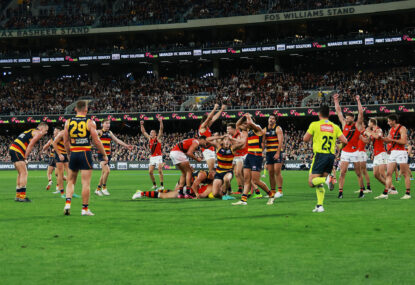This past weekend was a quintessential example of the value of the ‘premiership quarter’.
You know – the second.
Or perhaps, if you bleed yellow and black, the fourth.
Or maybe, it’s the second extra-time period?
Or could it be that the very concept of a ‘premiership quarter’ really IS a myth?
» Five talking points Port Adelaide vs West Coast
» Five talking points Sydney vs Essendon
» Five talking points Geelong vs Richmond
» Five talking points Adelaide vs GWS
The basic idea of the premiership quarter is defined as that period that makes or breaks your make-or-break games, which generally would mean those battles in September, where a loss ends your season.
Lance Skelton touched on this topic in this very forum last week, essentially calling the concept ‘fake news’ (as we Yanks are forced to say now) because no coach would ever suggest that the other quarters were less important. Which is certainly true.
But the concept of the third as the ‘premiership quarter’ has long legs, and not just in the AFL. That same feeling exists in almost every four-period sport.
One of the most prevalent strategies in American football at the initial coin flip is to defer the choice of possession to the third quarter kickoff, rather than simply accepting the ball with the opening kickoff of the game and guarantee that “extra possession” in hopes of getting off to a good start.
Most coaches seem to feel that it’s more important to get the second half moving quickly, the theory being that once you’ve made your halftime adjustments, you want to exploit them as rapidly as you can.
Even the major golf tournaments have an expression for the third of their four-day competitions – ‘moving day’. In other words, that’s the day that a golfer needs to put him or herself in a position to win. You can’t win a game in the third, but you can lose it.
As is my mathematical bent, I dug into the numbers to see if this whole thing was perception or reality in the AFL.
The games that truly matter towards the premiership, as the Bulldogs proved last year, are not the home-and-away contests (as long as you make the top eight) but the nine finals in September.

(AAP Image/Julian Smith)
So I examined the last ten years of finals data, going back to 2007, rather arbitrarily. Over those 95 games (ten seasons of nine games each, plus four so far this year and the grand final replay in 2010), I looked back through game records and narratives for the quarter that separated the eventual victor from the eventually vanquished, the quarter where the winner put its foot down and asserted their dominance on that day.
Using a rather broad definition of such quarters, the data does not back up the third quarter as the most valuable period of the four. In fact, you could argue that it was the least decisive term of the game!
If there had to be one dominant quarter in the winning team’s effort, this is how these 95 games broke down:
1st: 20 | 2nd: 21 | 3rd: 17 | 4th: 20
There were also 17 games where I wimped out trying to find such a quarter (although that included two extra time games and that drawn grand final).
That’s pretty non-definitive. Even the margin that the third quarter trails the other three is probably within the margin of error. And thinking about what championship teams actually do in games, this spread feels right to me.
Sometimes, a dominant team comes roaring out of the gate raring for blood (Hawthorn did this several times in their title run); sometimes, as with Sydney and Adelaide this week, there’s a ‘feeling out’ in the first period as the underdog holds it together against the pressure before the favourite goes on a run in the second. And in a close game, often a Richmond-pulling-away-from-Geelong-in-the-end scenario makes the fourth quarter the dominant period.
Now, here comes the interesting part of this study.
When I changed my criteria, or more precisely, changed the threshold of what makes for a dominant quarter, the numbers changed significantly.
If the only times we claim a dominant quarter was when that game definitively turned in that period, when one team obviously put its stamp on the game, here’s how the 44 such games broke down:
1st: 10 | 2nd: 11 | 3rd: 14 | 4th: 9
Suddenly, there’s our premiership quarter.
And if you take out last week’s three dominant games, the breakdown for the ten-year span is 10-9-14-8. (And the dynasty Hawks are responsible for many of those first-quarter throat-stompings).

(AAP Image/Julian Smith)
Why?
I’m not sure. Previously in this article, I’ve given reasons for each of the four quarters to be the place one team might dominate the other. If you choose to call this a statistical anomaly, that’s a legitimate argument; if you think the gap is statistically valid, so be it.
The bigger question is, ‘does any of this matter?’ Probably not. But then our little games’ don’t really matter, either, in any worldly sense, except to provide entertainment, a distraction from the world’s more significant matters, and a microcosm of our culture as a whole.
So maybe it’s an analogy for our lives. Don’t wait until the last minute to try to make a difference, and make full use of whatever chance you get to make ‘halftime adjustments’ in your life.
Or not. But it’s interesting to consider. (And by the way, my ELO-rating system picks Sydney and the Giants to win this weekend.)





































































































